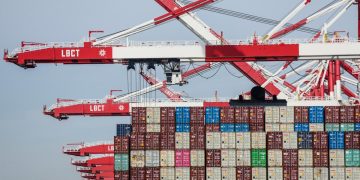The world’s two largest economic blocks, the United States and the European Union, have distinct labor market dynamics shaped by different economic, social, and policy environments. Both regions are grappling with the evolving nature of work, fueled by technological advances, demographic shifts, and changing global economic landscapes. The labor trends in Europe and the U.S. reveal similarities and significant differences that have far-reaching implications for workers, businesses, and policymakers. This article explores these trends, focusing on employment patterns, wage disparities, remote work, automation, and expert predictions for the future of the workforce on both sides of the Atlantic.
Analysis of Employment Trends and Workforce Demographics in Both Regions
Europe and the United States both face distinct challenges when it comes to employment trends. One of the most prominent demographic shifts influencing both regions is aging populations. In Europe, particularly in countries like Italy, Germany, and Spain, the aging population is creating significant pressure on the labor force. As the baby boomer generation reaches retirement age, many European countries are seeing declining labor force participation rates. This demographic change is not only limiting the size of the working-age population but also increasing the dependency ratio—where fewer working individuals are supporting a growing number of retirees.
In contrast, the United States has a somewhat younger population, with a larger proportion of its workforce in prime working age. However, even the U.S. is not immune to demographic changes. Immigration has traditionally helped offset labor shortages, especially in certain industries such as agriculture, hospitality, and technology. However, recent immigration policy shifts and the ongoing political debates surrounding immigration reform have raised questions about the future supply of labor.
Labor force participation rates in both regions also reveal interesting contrasts. The United States has a higher overall labor force participation rate compared to most European countries, though this difference has narrowed in recent years. A key factor in this trend is the relatively higher rate of female participation in the U.S. labor market, where more women are entering and remaining in the workforce due to evolving societal norms, economic necessity, and workplace reforms.
In Europe, labor markets are characterized by greater social safety nets, which sometimes act as a double-edged sword. While generous welfare systems in countries like France, Germany, and Sweden provide essential support for unemployed workers, they also create a disincentive to work for some segments of the population, leading to longer periods of unemployment in certain demographics. This is particularly the case for younger workers and those with lower skill levels, who often struggle to enter the labor market or are stuck in low-paying, temporary jobs.
The Impact of Remote Work and Automation on Labor Markets
The COVID-19 pandemic catalyzed a massive shift toward remote work, an evolution that is likely to remain a permanent feature of labor markets in both Europe and the U.S. However, the extent and nature of remote work differ between the two regions, influenced by cultural, economic, and infrastructure factors.
In the U.S., remote work surged as companies rapidly adapted to the pandemic’s restrictions. The shift was especially pronounced in industries like technology, finance, and consulting, where employees had the necessary tools and infrastructure to work from home. Many U.S. workers in urban areas, particularly in cities like New York and San Francisco, saw remote work as a long-term opportunity to escape the high cost of living. In fact, a significant portion of the American workforce now prefers remote or hybrid work arrangements, with surveys indicating that many workers would consider changing jobs if such options were not offered.
Europe experienced a similar shift, though with some key differences. In countries like Germany and the Netherlands, remote work has become a norm in many white-collar industries, but the transition was slower and more regionally varied compared to the U.S. In Southern European countries like Spain and Italy, remote work adoption was not as widespread before the pandemic, due to both slower technological adoption and cultural preferences for in-person interactions. However, even these countries saw a shift during the pandemic, with many workers now seeking hybrid work arrangements as the future of work continues to evolve.
Automation is another force reshaping labor markets in both regions, albeit at different paces. In the U.S., automation, particularly in manufacturing and logistics, has led to job displacement but also the creation of new, higher-skilled jobs in sectors like robotics and AI. The U.S. has a more robust tech ecosystem, with significant investments in automation technologies across industries. However, the downside is that automation has led to job polarization, where low-skill jobs are disappearing, and high-skill jobs in tech and engineering are on the rise.
In Europe, automation adoption has been somewhat slower but is catching up, especially in Germany’s industrial sectors, which are heavily reliant on manufacturing. Germany’s “Industry 4.0” initiative is a prime example of how Europe is embracing automation to enhance productivity. However, many Southern European countries still face challenges in implementing widespread automation, largely due to the smaller scale of industries and a reliance on labor-intensive sectors.

Insights into Wage Disparities, Productivity, and Job Creation
Wage disparities between the U.S. and Europe have long been a topic of discussion. On average, U.S. wages are higher than those in many European countries, especially in industries like technology, finance, and healthcare. This wage gap is partly due to differences in taxation, cost of living, and social safety nets. The U.S. labor market is also more flexible, allowing businesses to offer higher wages in order to attract and retain talent in a highly competitive environment.
In contrast, many European countries maintain higher levels of job security and offer more extensive benefits, such as paid parental leave and universal healthcare, which can offset the lower base wages. Countries with strong union representation, such as France and Sweden, typically see higher levels of wage equality, though wage growth has been slower compared to the U.S. in recent years.
The relationship between wages and productivity is another area where the two regions diverge. In the U.S., wages have lagged behind productivity growth for several decades, leading to concerns about income inequality. In Europe, while wage growth has also been relatively stagnant, productivity gains have generally been more evenly distributed, particularly in Scandinavian countries, where strong labor unions negotiate higher wages tied to productivity improvements.
In terms of job creation, both regions are seeing growth in the tech sector, driven by the digital transformation of economies. However, Europe has faced challenges in creating jobs in some areas, particularly in Southern and Eastern Europe, where youth unemployment remains high. The U.S., on the other hand, has seen robust job creation in technology and service sectors, with tech giants like Amazon, Apple, and Google continuing to expand their workforce.
Expert Opinions on the Long-Term Outlook for the Transatlantic Workforce
Looking ahead, experts predict that the labor markets in both Europe and the U.S. will continue to evolve, shaped by technological advances, demographic shifts, and geopolitical factors. The future of the transatlantic workforce will depend on how well both regions address challenges such as automation, job displacement, and inequality.
In the U.S., experts anticipate continued growth in tech-related fields, particularly in artificial intelligence, robotics, and cybersecurity. However, there are concerns that the U.S. will face significant skill gaps, as many workers are not prepared for the technological demands of the future labor market. To address this, the U.S. will need to invest heavily in education, upskilling, and workforce retraining programs to ensure that workers can transition to higher-skill jobs.
Europe faces a similar challenge but is somewhat ahead in terms of integrating social policies that support workers through transitions. The European Union’s Green Deal and digital strategy are expected to create significant employment opportunities in renewable energy, technology, and green industries. However, much of Europe’s labor market reform will depend on overcoming the challenges posed by an aging population and a lack of integration across different national labor markets.
Both regions will also need to address the growing issue of inequality, particularly as labor markets become more polarized due to automation. Ensuring that the benefits of technological advancement are shared more equally will be crucial in maintaining social stability and economic growth.
Conclusion
The transatlantic workforce is undergoing significant changes, driven by shifting demographics, technological advances, and changing global economic dynamics. While Europe and the U.S. share some common challenges, such as the impact of remote work and automation, they also exhibit key differences in their labor markets. These differences present unique opportunities and challenges for businesses and workers on both sides of the Atlantic. As we move into the future, understanding these trends and preparing for the changes ahead will be crucial for both policymakers and investors.
































